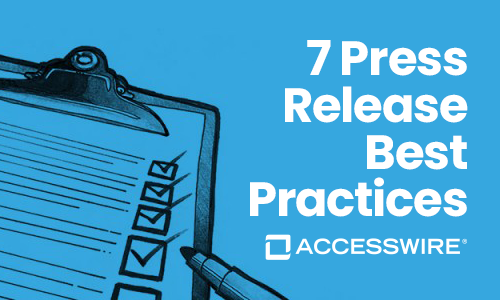When to Send a Media Alert vs. Press Release
The difference between a media alert and a press release is one of the most important distinctions in public relations. However, given the similarities between these two types of announcements, the distinction is easy to miss. Understanding the difference between the two will be critical in your press release distribution strategy.
In general, a press release is much longer than a media alert, but the differences between a media alert and a press release extend much further than the length of the genre.
In this article, we’ll cover all you need to know about the media alert vs. press release. Not only will we cover the differences between a media alert and press release, but we’ll also discuss when to send each one based on your overall strategy and tips for composing each.
Is a Media Alert a Press Release?
Media alerts and press releases are similar in that they seek to provide journalism’s “Five Ws” (the who, what, where, when, and why”) when spreading an announcement.
To this extent, a media alert is a type of press release. Or, to look at it another way, all media alerts are, in essence, press releases but not all press releases are media alerts.
What separates the two forms is their content and structure. Let’s take a deeper look at the differences between media alerts and press releases by focusing on the following: purpose, content and organization, length and timing, and target audience.
Purpose
Though the goal of both types of announcements is to provide information, the reason for doing so differs between the genres.
- Press releases are narrative by nature. Different types of press releases exist to detail the specifics of an event, new hire, rebranding initiative, etc., by following an essayistic form. In short, their purpose is to give journalists and media members a detailed overview of what is happening.
- Media alerts, on the other hand, are thought of as “invitations.” While their purpose is, in part, to inform, they exist mainly to try and convince media members to attend an event. Unlike press releases, they give a bare-bones outline, utilizing bullet points to convey information rather than chunks of text.
Content and Organization
These two types of content also differ in content and organization to help them succeed in their goals.
As one of the most versatile pieces of writing, the press release accomplishes many objectives—from announcing new partnerships to letting the public know about new charity initiatives. As such, the content of the press release varies, but the overall structure remains the same.
In general, press releases follow an “inverted pyramid” structure in which the most important information (the Five Ws) is stated at the beginning of the release. The press release also contains the following components:
- Headline
- Summary
- Date and location
- Body
- Boilerplate
- End or close
Regardless of the news, all press releases look like stories. They’re composed of blocks of text and include the signposts of narrative reporting—quotes and detailed information.
Media alerts, however, look like bulleted lists of information. Like press releases, they contain the event’s “Five Ws.” But unlike press releases, they contain just enough information to let media members know the event’s basic facts.
Additionally, good media alerts contain the following:
- A brief, specific headline
- A sub-headline adding information or clarifying details about the event
- Contact information
- The event’s “Five Ws” in bullet points
- Any event sponsor information (email address, logo, contact information)
Length and Timing
Because each type of content serves a different purpose, their length and timing also differ.
Length
Because press releases contain more detailed information, they’re longer than media alerts. On average, press releases are usually around 300-400 words.
Media alerts are much shorter. Containing only the basic details of an upcoming event, media alerts are rarely longer than a page.
Timing
In terms of timing, if a press release isn’t announcing an event that has a specified date and time, it’s sent out when relevant. This is not to say that the timing of a press release doesn’t matter (you don’t want to distribute a press release the day before a holiday, for instance). But it is to say that unless it’s announcing an event with a specified date and time, it has a more flexible release schedule.
Most media alerts, however, are usually distributed twice. The first distribution service occurs a few weeks before the event. The second distribution’s typically a day before the event and serves as a reminder.
Audience
Another difference between media alerts and press releases is the target audience.
- Press releases are meant to be seen by a large audience of media members. For example, suppose a prominent book distributor is unveiling a new line of young adult novellas. They would most likely use a press release to announce this information because this announcement is not so much an invitation to a specific event as it’s a general announcement.
- Media alerts are distributed to a much smaller, local audience. This is because the primary role media alerts serve is that of an invite. Now, suppose the book distributor is announcing the release of these novellas in a single city. Because the event is localized and specific, and because the book distributor wants journalists to attend the event, a media alert is the best move.
Media Alert vs. Press Release: Which One To Use?
As stated above, although media alerts and press releases contain the “Five Ws,” they serve different purposes. Furthermore, the type of announcement you use depends on your strategy.
Below, we’ve broken down when to send each type of announcement:
When To Send a Press Release
Press releases are crucial when you need to announce a major news story that requires more detail.
Remember: while some press releases can serve as “invites,” their primary purpose is to inform.
Consider using a press release when you’re announcing the following news:
- Major changes – If you’re announcing major changes within your organization, such as a rebranding or a merger, it’s best to use a press release. This is because major changes often require stakeholders to be notified. You want to provide as much information as possible to major stakeholders so that any fears or anxieties are lessened.
- New product or feature launch – Launching a new product or feature often requires more room than a series of short bullet points can provide. Not only do you want to include the specifics of the product or feature, but you might also want to project how the company’s revenue will change based on the addition of this new line.
- New hire – Similar to a new partnership or rebranding, new hires, especially if they occur at the executive level, warrant a press release. This is because announcing new hires means more than simply stating the new hire’s name. You also want to announce their background and what they bring to the company.
When to Send a Media Alert
Because media alerts are concise, direct, and invitational, they’re best used for events that have a specified date, time, and location. Their goal isn’t to provide extensive information, but to provide details about when and where the event is taking place.
Consider sending a media alert to announce the following:
- Press conferences
- Book launches
- Town halls
- Art and music shows
- Award ceremonies
Tips for Writing a Press Release
Now that we’ve covered the differences between press releases and media alerts, let’s discuss press release best practices for writing compelling and effective announcements.
To write an effective press release, heed the following tips:
- Write engaging headlines – The best headlines captivate audiences immediately. Be sure to use action words and keep headlines short—no more than 100 characters.
- Organize effectively – Always assume that audiences will only read your press release’s headline and summary. Organize your press release using an “inverted pyramid” structure, including the most important information, the “Five Ws,” at the beginning of the release. When it comes to how to end a press release, make sure your closing paragraph illuminates your overall message and its relevance.
- Time it right – Although you have more flexibility when it comes to press releases vs. media alerts, timing is still everything, so finding the best time to send a press release matters. For best results, don’t send press releases on a Friday or before a holiday.
Tips for Writing a Media Alert
The best media alerts provide just the right information to entice media members to attend an event. They’re never cluttered or confusing, and their intention is always clear.
Additionally, consider the following ways to make your media alert stand out:
- Brevity is everything – Media alerts should be brief (no longer than a page) and only include the “Five Ws” of an event. Bulleted lists are the most effective organizational strategy.
- Alert with your subject line – Media alerts don’t have to be fancy. Let the media know exactly what to expect by stating “Media Alert” in the subject line.
- Know your audience – Unlike a press release, a media alert isn’t intended for wide distribution. Send your alert to a local group of media members who share the event’s interest.
Announce With ACCESSWIRE
Knowing when to send a press release vs. a media alert is crucial to a successful public relations campaign. Whereas press releases are generally longer and filled with more information, media alerts are brief, inviting media members to cover an event.
Regardless of the type of announcement you need to send, ACCESSWIRE has you covered.
By connecting your news coverage with the widest possible audience for the most cost-effective, flat-fee pricing, ACCESSWIRE is committed to being the best press release service in the industry. Connect today and see why ACCESSWIRE is the corporate storyteller of choice.
Sources:
Compendent. Media Alert vs Press Release: Which is Best to Use?
The Guardian. How to write an effective press release.
Wisconsin Historical Society. How to Alert the Media about Your Historic Preservation Event.
Similar Blog Posts
PRODUCTS
ACCESSWIRE | All Rights Reserved




